Wind Turbine Blade Design Innovations Explained
Category: Renewable Energy
Discover Innovations in Wind Turbine Blade Design
If you’re fascinated by renewable energy—whether you’re just starting to explore or are an electrical engineer seeking a deeper dive—understanding the latest innovations in wind turbine blade design is key to appreciating how wind energy is evolving. Maybe you’ve wondered how blades have become longer, lighter, and more efficient without sacrificing durability or how new materials and aerodynamic tweaks can unleash more power from the wind. This article offers a clear yet detailed exploration of these advances, bridging the gap between beginner curiosity and engineering rigor. Unlike many overly technical or superficial pieces, this post walks you through the science and engineering breakthroughs reshaping blade design, showing the why and how behind trends like smart blades, biomimicry-inspired shapes, and composite innovations. As you read on, you’ll gain insight into aerodynamic optimizations, material science, load management, and manufacturing techniques driving the industry forward. This empowering knowledge will help you grasp the cutting-edge science behind one of the fastest-growing clean tech sectors and inspire ideas for innovation or application in your own projects or studies.
- Discover Innovations in Wind Turbine Blade Design
- Overview of Wind Turbine Blades: Basic Design Principles and Their Role in Energy Capture Efficiency
- Material Innovations: Advancing Strength-to-Weight Ratio and Durability in Wind Turbine Blades
- Aerodynamic Enhancements: New Blade Profiles, Twist and Taper Strategies, and Serrated Edges
- Load Management Technologies: Methods to Mitigate Fatigue and Extreme Loads
- Blade Manufacturing Advancements: Automated Fabrication, Modular Designs, and Cost-Reduction Techniques
- Smart and Adaptive Blades: Integration of Sensors and Actuators for Real-Time Shape Adjustment and Performance Optimization
- Biomimicry and Nature-Inspired Designs: Leveraging the Wisdom of Whales, Birds, and Nature for Superior Blade Performance
- Longer and Larger Blades: Engineering Challenges and Innovations Enabling the Growth in Blade Size to Capture More Energy
- Environmental and Sustainability Considerations: Use of Recyclable Materials and Design for End-of-Life Blade Disposal
- Future Trends and Emerging Technologies: Ultra-Light Materials, Digital Twins, and Hybrid Renewable Integration
Overview of Wind Turbine Blades: Basic Design Principles and Their Role in Energy Capture Efficiency
Wind turbine blades are the critical interface between the natural energy of the wind and the mechanical power that drives electricity generation. Their design principles revolve around maximizing aerodynamic efficiency while balancing structural strength and weight. Typically, blades are designed as elongated airfoils—shaped like airplane wings—to optimize lift and reduce drag, enabling them to capture as much wind energy as possible. Key factors in blade design include the blade length, chord distribution (width variation along the blade), and twist angle, all tailored to ensure that different sections of the blade interact efficiently with varying wind speeds along the span.
The efficiency of wind energy conversion heavily depends on these aerodynamic parameters. Longer blades sweep a larger area, capturing more wind energy, but also introduce greater mechanical loads, demanding innovative materials and structural designs. Additionally, blade shape influences tip-speed ratio, which is the ratio of blade tip speed to wind speed and a critical metric for optimizing power extraction without causing excessive noise or vibrations. Consequently, modern blade design integrates computational fluid dynamics (CFD) simulations and wind tunnel testing to refine the aeroelastic behavior—how blades flex under wind loads—to maintain energy capture efficiency over a broad range of operating conditions. Understanding these foundational design aspects is essential to appreciating the breakthroughs in advanced materials, smart control systems, and biomimetic forms that form the next wave of wind turbine blade innovation.
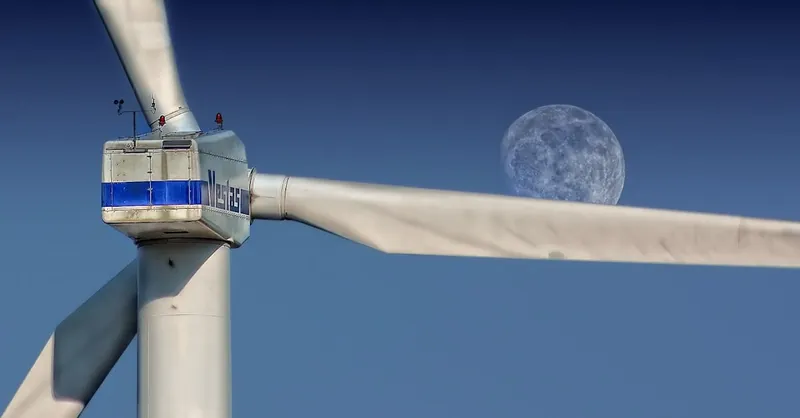
Image courtesy of Pixabay
Material Innovations: Advancing Strength-to-Weight Ratio and Durability in Wind Turbine Blades
One of the most significant drivers behind the evolution of wind turbine blade design is material innovation. Traditional blades were primarily constructed from fiberglass-reinforced polyester resins, offering a balance of cost and performance but posing limitations in terms of weight and long-term durability. Today, the industry is rapidly adopting advanced composite materials, especially carbon fiber-reinforced polymers (CFRPs), and novel resin systems that dramatically improve the strength-to-weight ratio while enhancing resistance to fatigue and environmental degradation.
Carbon Fiber Composites: Reducing Weight Without Compromising Strength
Carbon fiber composites are prized for their exceptional tensile strength and low density, enabling blades to become longer and lighter simultaneously. This reduction in weight decreases centrifugal and gravitational loads on the turbine structure, allowing for larger rotors that capture more wind energy without proportionally increasing mechanical stress. Moreover, carbon fibers exhibit excellent stiffness, which helps maintain blade shape under heavy wind loads, optimizing aerodynamic performance over the turbine’s lifetime.
Next-Generation Resins and Hybrid Materials: Enhancing Durability and Impact Resistance
Alongside carbon fibers, advances in thermoset and thermoplastic resins enhance blade durability by improving resistance to UV radiation, moisture ingress, and lightning strikes—common factors that degrade blade integrity. Hybrid composites that combine carbon fiber with glass fiber layers strategically balance cost and mechanical properties. Additionally, newly formulated resins with better toughness and curing characteristics enable faster manufacturing cycles and heavier, defect-free blades.
Key Benefits of Material Innovations
- Improved Load Management: Lightweight composites reduce mechanical stress, extending blade lifespan.
- Increased Blade Lengths: Stronger materials support longer blades for higher energy capture efficiency.
- Enhanced Fatigue Resistance: Advanced resins reduce micro-cracking and structural wear from cyclic wind loads.
- Environmental Resilience: Improved resistance to weather, erosion, and lightning damage lowers maintenance costs.
These material breakthroughs underpin the ongoing trend toward larger, more efficient wind turbines that are not only greener but also economically competitive. As research continues into novel fibers, bio-based composites, and smart materials embedded with sensors, the future of wind turbine blades looks stronger, lighter, and smarter than ever before.
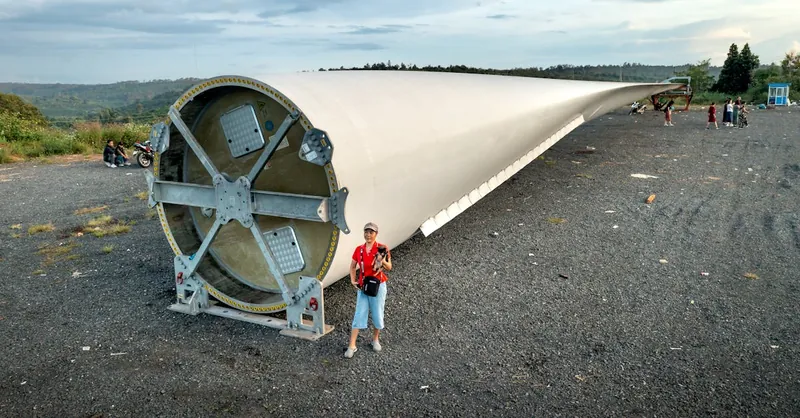
Image courtesy of Quang Nguyen Vinh
Aerodynamic Enhancements: New Blade Profiles, Twist and Taper Strategies, and Serrated Edges
Optimizing the aerodynamics of wind turbine blades is crucial to maximizing energy capture while minimizing noise and structural loads. Recent innovations in blade profiles, twist distribution, and edge designs have significantly advanced aerodynamic efficiency, enabling turbines to operate more quietly and generate more power even at lower wind speeds.
Innovative Blade Profiles for Increased Lift and Reduced Drag
Modern blades utilize refined airfoil shapes that are carefully engineered to enhance the lift-to-drag ratio, a key factor in aerodynamic performance. These advanced profiles often feature thicker leading edges and smoother curvature transitions, improving airflow attachment and delay of stall. By increasing lift while reducing drag forces, blades convert more wind energy into rotational power more effectively, especially across a wider range of wind conditions.
Tailored Twist and Taper for Optimal Load Distribution
The twist angle—the gradual change in blade pitch from root to tip—is critical to ensuring that each blade section interacts with the wind at its ideal angle of attack. New design strategies employ variable twist and taper, where the chord width decreases towards the tip, to optimize local aerodynamic conditions along the entire blade span. This approach not only maximizes energy extraction but also balances aerodynamic loads to reduce structural fatigue and prolong blade life.
Serrated Edges and Trailing-Edge Modifications to Reduce Noise
One of the challenges with large blades is aerodynamic noise generated by turbulent airflow, which can restrict turbine installation near residential areas. To address this, designers have incorporated serrated trailing edges—also known as “keels” or “sawtooth edges”—that break up vortex formation and reduce pressure fluctuations that cause noise. These serrations significantly diminish broadband noise while maintaining or improving aerodynamic lift, allowing turbines to operate more quietly without sacrificing efficiency.
Key Benefits of Aerodynamic Enhancements:
- Higher energy capture through improved lift-to-drag characteristics.
- Reduced mechanical stress due to optimized load distribution along the blade.
- Lower operational noise, facilitating greater community acceptance and enabling wider deployment.
- Enhanced performance at low wind speeds, expanding viable locations for wind farms.
These aerodynamic advancements reflect a sophisticated integration of fluid dynamics research, wind tunnel testing, and computational modeling. By fine-tuning blade shapes, twist angles, and edge designs, manufacturers continue to push the boundaries of what wind turbine blades can achieve, driving forward the efficiency and sustainability of wind energy technology.
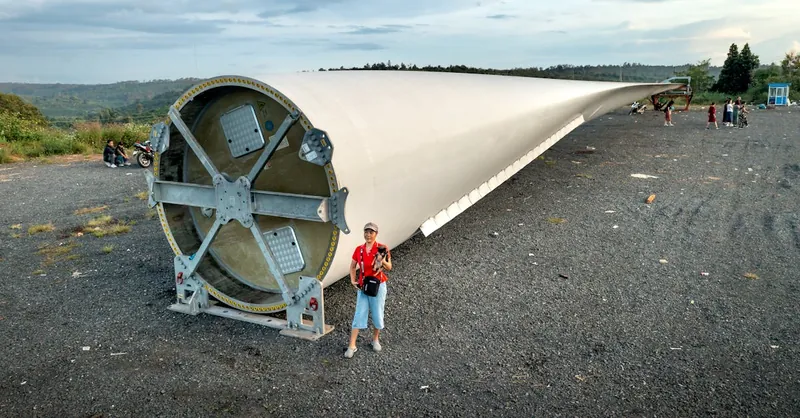
Image courtesy of Quang Nguyen Vinh
Load Management Technologies: Methods to Mitigate Fatigue and Extreme Loads
Effective load management is essential in modern wind turbine blade design to ensure longevity, reliability, and optimal performance under varying and often extreme wind conditions. Blades are constantly subjected to complex aerodynamic and gravitational loads that cause fatigue stress and risk of structural failure. Innovations in load mitigation techniques—such as pitch control systems, flexible blade architectures, and integrated sensor technologies—play a critical role in reducing mechanical strain and extending blade service life.
Pitch Control: Dynamic Adjustment for Load Alleviation
Pitch control systems adjust the angle of the blades in real time to regulate the aerodynamic forces acting on the rotor. By rotating the blades around their longitudinal axis, pitch control can optimize the angle of attack to:
- Maximize energy capture at moderate winds.
- Reduce aerodynamic loads during gusts or extreme wind speeds.
- Minimize structural stress by preventing over-speed conditions.
This active control mechanism not only enhances power output but also significantly mitigates fatigue damage caused by cyclic loading, effectively balancing performance and durability.
Flexible Blades: Blending Stiffness with Adaptability
Another innovative approach involves designing blades with flexible structures that can elastically bend in response to wind forces. Unlike traditional rigid blades, these flexible blades dissipate loads by deforming, reducing peak stresses transmitted to the turbine hub and tower. Advances in composite materials and structural engineering now enable blades to achieve a finely tuned balance between stiffness for aerodynamic efficiency and flexibility for load absorption. This adaptability improves resilience against turbulent wind conditions and lowers maintenance requirements over time.
Sensor Integration: Real-Time Monitoring and Smart Load Management
Embedding sensors within blade materials has opened new avenues for proactive load management. These sensors continuously monitor parameters such as strain, vibration, temperature, and blade deformation, enabling turbine controllers to react swiftly to emerging stress patterns. Data from sensors feed into smart control algorithms that optimize blade pitch and operational parameters, dynamically mitigating fatigue risks and preventing potential failures. This real-time feedback loop is a key component of predictive maintenance strategies, enhancing the reliability and lifecycle management of wind turbines.
Benefits of Load Management Innovations
- Reduced Fatigue and Structural Damage: Extends blade lifespan by managing cyclic and extreme loads.
- Improved Energy Efficiency: Maintains optimal aerodynamic conditions under varied wind speeds.
- Lower Maintenance Costs: Early detection and dynamic response prevent costly repairs and downtime.
- Enhanced Operational Safety: Minimizes risk of catastrophic blade failure during storms or gusts.
By integrating these load management technologies, the wind energy industry is pushing blade design beyond static strength considerations toward smart, adaptive systems that ensure turbines withstand the demands of ever-larger rotor sizes and harsh environmental conditions. These advances are pivotal in supporting the deployment of larger, more powerful turbines that deliver clean energy sustainably and economically.
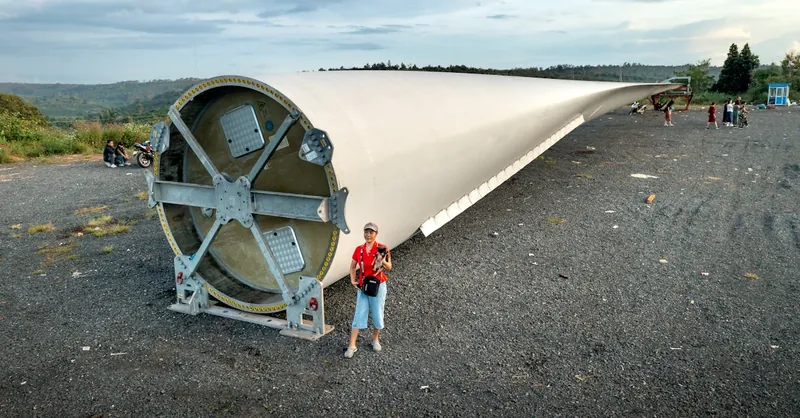
Image courtesy of Quang Nguyen Vinh
Blade Manufacturing Advancements: Automated Fabrication, Modular Designs, and Cost-Reduction Techniques
The rapid growth in wind turbine size and demand has driven significant advancements in blade manufacturing to meet scalability, quality, and cost targets. Traditional manual fabrication methods—often labor-intensive and time-consuming—are increasingly being replaced by automated manufacturing processes that enhance precision and throughput. Automation integrates advanced robotics, computer-aided manufacturing (CAM), and digital control systems that ensure consistent blade quality while reducing production time and human error.
Automated Fabrication: Increasing Precision and Production Speed
Modern wind turbine blade manufacturing leverages robotic resin infusion, automated fiber placement, and laser-guided cutting tools to fabricate composite structures with extreme accuracy. These automated technologies offer multiple benefits:
- Uniform material distribution improves structural integrity by eliminating resin voids and fiber misalignment.
- Higher repeatability ensures consistency across large production batches, essential for turbine fleets.
- Faster cycle times lower production costs and enable rapid deployment of new blade designs.
Moreover, digital twins and real-time sensor feedback during fabrication enable manufacturers to monitor curing processes and detect defects early, improving overall blade reliability.
Modular Blade Designs: Facilitating Transportation and Assembly
As blades have grown beyond 80 meters in length, challenges in transportation and installation have spurred innovation in modular blade designs. These blades are engineered in multiple segments or sections that can be manufactured independently, transported separately, and then assembled onsite or near the wind farm location. Benefits of modular design include:
- Overcoming logistics constraints, allowing access to remote or urban areas where traditional full-length blade transport is impractical.
- Reduced transport costs and risks, as smaller blade segments are easier to handle and less sensitive to damage.
- Design flexibility that permits site-specific blade tuning by varying segment configurations.
Continued R&D focuses on developing reliable joining methods, such as advanced adhesive bonding and mechanical fasteners, to maintain structural continuity and aerodynamic performance between blade modules.
Cost-Reduction Techniques for Large-Scale Production
To ensure wind energy remains competitive with fossil fuels and other renewables, manufacturers are optimizing production costs through:
- Material efficiency improvements, including optimized fiber layup patterns that reduce waste without compromising strength.
- Advanced curing technologies like out-of-autoclave and microwave curing that lower energy consumption and speed up manufacturing cycles.
- Lean manufacturing principles that streamline workflows, minimize inventory, and reduce manual labor inputs.
Collectively, these blade manufacturing innovations are crucial for scaling wind power deployment globally. By enhancing fabrication precision, enabling modular scalability, and driving down costs, the industry is poised to deliver larger, more efficient blades faster and cheaper than ever before—accelerating the transition to clean, renewable wind energy worldwide.
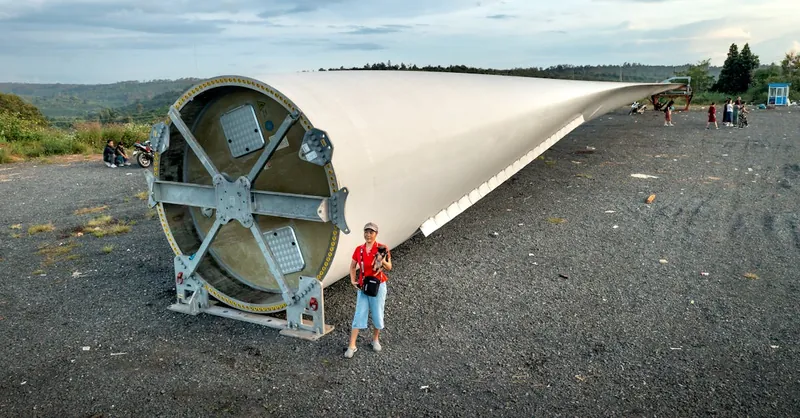
Image courtesy of Quang Nguyen Vinh
Smart and Adaptive Blades: Integration of Sensors and Actuators for Real-Time Shape Adjustment and Performance Optimization
The next frontier in wind turbine blade design lies in smart and adaptive blades that dynamically adjust their shape and behavior in response to changing wind conditions. By integrating sensors, actuators, and advanced control algorithms directly into the blade structure, these intelligent systems optimize aerodynamic performance and load management in real time, significantly enhancing energy capture and structural resilience.
Real-Time Shape Morphing for Optimal Aerodynamics
Smart blades are equipped with embedded flexible actuators that enable subtle alterations in blade geometry—such as twisting, bending, or camber modification—while the turbine is operating. This real-time shape adaptation allows blades to maintain the optimal angle of attack across a wide range of wind speeds and turbulence levels, maximizing lift and minimizing drag continuously rather than relying on fixed aerodynamic settings. Unlike traditional pitch control alone, active morphing can fine-tune the blade profile along its span, addressing localized flow variations and reducing aerodynamic loads more precisely.
Embedded Sensor Networks for Continuous Monitoring
To enable adaptive control, smart blades integrate dense networks of strain gauges, fiber optic sensors, and pressure transducers that monitor mechanical stress, vibration, temperature, and aerodynamic forces throughout the blade. This constant data stream empowers the turbine’s control system to detect early signs of fatigue, wind gust impacts, or aerodynamic inefficiencies, and command actuators to adjust blade shape accordingly. Such feedback loops enhance predictive maintenance, prevent structural damage, and improve energy yield by maintaining peak aerodynamic conditions.
Benefits of Smart and Adaptive Blade Technologies
- Maximized Energy Efficiency: Continuous shape optimization improves aerodynamic performance under fluctuating wind conditions.
- Extended Blade Lifespan: Dynamic load alleviation reduces fatigue stress and structural wear.
- Noise Reduction: Fine-tuned shape adjustments can minimize aerodynamic noise by smoothing airflow separations.
- Enhanced Grid Integration: Adaptive blades enable smoother power output by mitigating the effects of wind gusts and turbulence.
The ongoing development of smart and adaptive wind turbine blades represents a paradigm shift from static, rigid rotor components to intelligent, responsive systems. By harnessing advanced material science, embedded electronics, and control engineering, these innovations significantly boost the operational flexibility and sustainability of wind energy—a critical advancement as global wind farms scale up to meet increasing renewable energy demands.
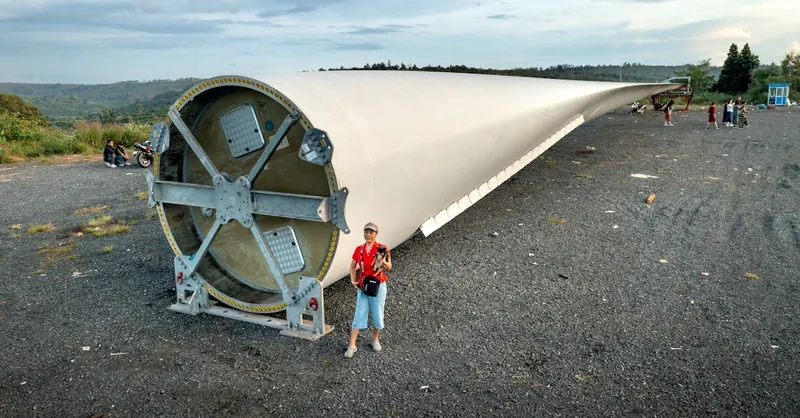
Image courtesy of Quang Nguyen Vinh
Biomimicry and Nature-Inspired Designs: Leveraging the Wisdom of Whales, Birds, and Nature for Superior Blade Performance
An exciting frontier in wind turbine blade innovation is biomimicry—the emulation of natural forms and mechanisms to enhance blade efficiency and durability. Engineers and researchers are increasingly turning to nature-inspired designs, drawing insights from the shapes and structures of whale fins, bird wings, and other biological models refined through millions of years of evolution. These inspirations help overcome traditional aerodynamic and structural challenges, unlocking new performance potentials in wind energy capture.
Whale Fin-Inspired Tubercled Leading Edges
One of the most influential biomimetic concepts stems from the humpback whale’s flippers, which feature distinctive bumps called tubercles along their leading edges. These irregularities enable whales to maneuver gracefully by manipulating water flow to delay stall and reduce drag. When applied to wind turbine blades, tubercled leading edges generate vortex flows that improve lift and maintain smoother airflow separation even under turbulent conditions. This results in:
- Enhanced aerodynamic efficiency at low and moderate wind speeds.
- Improved stall resistance, allowing blades to operate effectively in a wider variety of wind conditions.
- Noise reduction due to stabilized airflow and fewer turbulent eddies.
Bird Wing Aerodynamics: Optimizing Twist and Flexibility
Bird wings provide a natural template for managing lift and load through adaptive flexibility and segmented structure. Inspired by avian flight mechanics, advanced blades incorporate variable twist and flexible joints that mimic wing feather arrangements, enabling better load distribution and active shape control. These designs contribute to:
- Dynamic aerodynamic tuning, where blade sections adapt to local flow conditions.
- Reduced structural fatigue by absorbing gust-induced stresses through controlled flexibility.
- Increased overall energy capture by optimizing the blade’s airflow interaction continuously.
Other Nature-Inspired Features
Beyond whales and birds, innovations include surface textures modeled after shark skin to minimize drag and deter ice accumulation, and tree branch-inspired branching patterns in internal spar designs to improve structural resilience while reducing weight. These bioinspired strategies are progressively integrated with composite materials and smart sensing to enhance the blades’ performance sustainably.
Why Biomimicry is Transforming Wind Turbine Blade Design
- Increased Energy Capture: Nature-inspired modifications improve lift-to-drag ratios, boosting power output.
- Load Mitigation: Flexible and adaptive features reduce fatigue and extend blade lifespan.
- Noise Suppression: Aerodynamic enhancements derived from biological templates minimize operational noise pollution.
- Sustainability: Mimicking efficient natural structures helps optimize material use and reduce environmental impact.
By bridging biology and engineering, biomimicry elevates wind turbine blade design beyond conventional limits, fostering innovations that are aerodynamic, durable, and environmentally attuned. This synergy of natural wisdom and cutting-edge technology is shaping the next generation of wind turbines that are smarter, quieter, and more efficient—accelerating the transition to sustainable renewable energy worldwide.
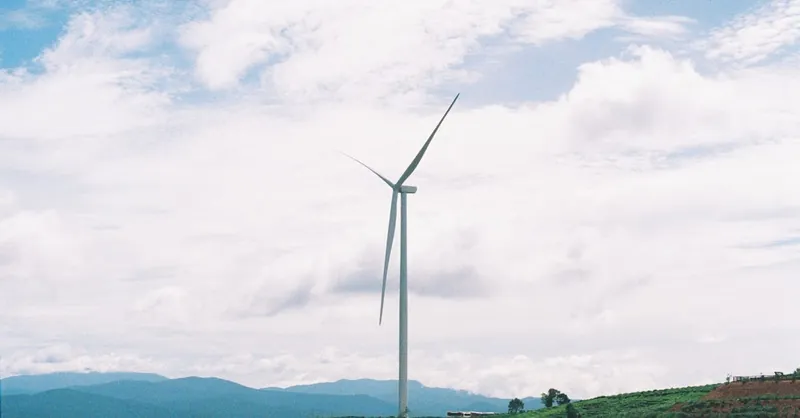
Image courtesy of Duc Nguyen
Longer and Larger Blades: Engineering Challenges and Innovations Enabling the Growth in Blade Size to Capture More Energy
The continuous push for longer and larger wind turbine blades is driven by the simple physics principle that increasing a blade's length enhances its swept area, enabling turbines to capture significantly more wind energy. In recent years, blade lengths have surged past 80 meters, with some prototypes exceeding 100 meters, fundamentally transforming the potential capacity and efficiency of modern wind farms. However, scaling up blade size introduces a complex set of engineering challenges that require groundbreaking innovations in materials, structural design, load control, and manufacturing techniques to ensure safety, durability, and cost-effectiveness.
Structural and Material Engineering Challenges
As blades grow longer and larger, the mechanical loads—including bending moments, torsion, centrifugal and gravitational forces—rise exponentially, demanding ultra-high strength-to-weight ratios to avoid excessive stresses and deformation. The increased blade mass also intensifies fatigue loading from cyclic wind forces, elevating the risk of material fatigue, cracks, and eventual failure if not properly managed. Larger blades must maintain aeroelastic stability, balancing stiffness to sustain aerodynamic shapes while allowing controlled flexibility to dissipate loads without structural damage.
To address these demands, engineers leverage:
- Advanced carbon fiber composites for lightweight, high-stiffness structures.
- Hybrid material layouts combining carbon and glass fibers tailored to load zones.
- Innovative internal spar and shear web designs that optimize strength distribution without excessive weight.
These improvements enable blades to resist extreme forces while maintaining operational efficiency and longevity.
Innovations Enabling Manufacturing and Transportation
Manufacturing and transporting massive blades pose logistical and economic challenges. Innovations designed to overcome these barriers include:
- Segmented and modular blade construction, allowing blades to be fabricated in parts that are easier to transport and assembled onsite, reducing costs and expanding wind farm siting options.
- Automated fabrication techniques, such as robotic fiber placement and resin infusion, ensure precision and quality for larger components.
- Advanced blade joining and bonding technologies to guarantee mechanical continuity and aerodynamic integrity at segment interfaces.
Ultimate Benefits of Larger Blade Designs
- Significantly increased energy capture thanks to larger swept areas.
- Enhanced cost-effectiveness, as more power is generated per turbine, lowering levelized cost of energy (LCOE).
- Improved performance at lower wind speeds, expanding viable locations for wind power deployment.
- Longer operational lifespans by integrating innovative stress management and fatigue-resistant materials.
In sum, breaking the size barrier with longer and larger wind turbine blades represents a monumental leap in renewable energy technology, combining advanced materials science, structural engineering, and manufacturing innovation to unlock vast new potentials in scalable, clean wind power generation.
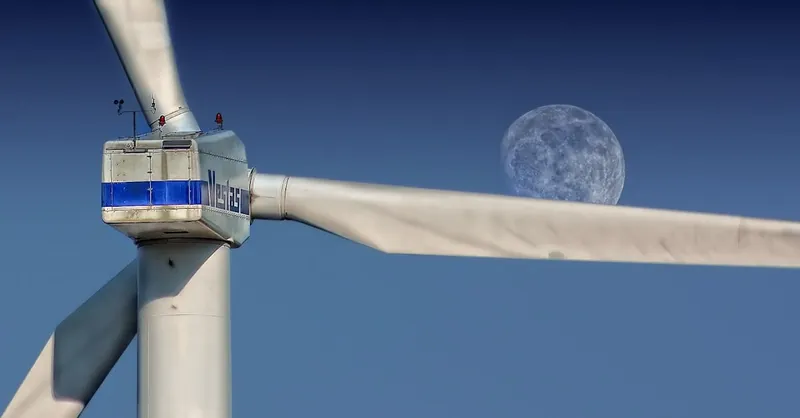
Image courtesy of Pixabay
Environmental and Sustainability Considerations: Use of Recyclable Materials and Design for End-of-Life Blade Disposal
As wind energy scales rapidly worldwide, addressing the environmental impact and sustainability of wind turbine blades throughout their lifecycle has become a critical focus in blade design innovation. Traditionally, blades are constructed from composite materials—primarily fiberglass-reinforced polymers—that are highly durable but notoriously difficult to recycle or repurpose at the end of their service life. This challenge raises significant concerns about long-term waste management, landfill accumulation, and the carbon footprint associated with blade disposal.
Advancements in Recyclable and Sustainable Blade Materials
To promote a circular economy within the wind industry, researchers and manufacturers are developing new blade materials and composites that retain high strength-to-weight performance while enabling recyclability. Key innovations include:
- Thermoplastic composites that can be reheated and reshaped, unlike conventional thermoset resins which cure into irreversible structures.
- Bio-based resins and natural fiber reinforcements derived from sustainable sources like flax, hemp, or cork, reducing dependency on petroleum-based inputs and enhancing biodegradability.
- Recyclable glass and carbon fiber composites designed for chemical or mechanical recycling processes to reclaim fibers for reuse in new blades or other applications.
These materials aim to reduce the environmental burden by facilitating processing technologies such as grinding, pyrolysis, or solvolysis that recover valuable fibers while minimizing energy consumption during recycling.
Design for End-of-Life: Modular and Disassemblable Blades
Beyond material innovation, design for end-of-life (DfE) strategies are increasingly embedded into blade development to simplify recycling and disposal:
- Modular blade architectures that allow easy separation of components and materials during decommissioning.
- Use of reversible adhesives and mechanical fasteners over permanent bonding methods, enabling dismantling without damaging materials.
- Integration of marking systems and digital tracking to inform recyclers about material composition and optimal recycling pathways.
Environmental and Economic Benefits of Sustainable Blade Design
- Reduced landfill waste, lowering environmental contamination and footprint.
- Lower lifecycle carbon emissions by minimizing raw material extraction and production energy.
- Enhanced material circularity, promoting cost-effective reuse and resource efficiency.
- Improved social acceptance of wind technology by addressing ecological impact concerns.
By prioritizing recyclable materials and designing blades with end-of-life considerations, the wind energy sector strengthens its commitment to sustainability, ensuring that the push for clean power does not come at the expense of environmental responsibility. These innovations not only align with global ESG goals but also support regulatory compliance and future-proof the viability of wind power as a truly green energy solution.
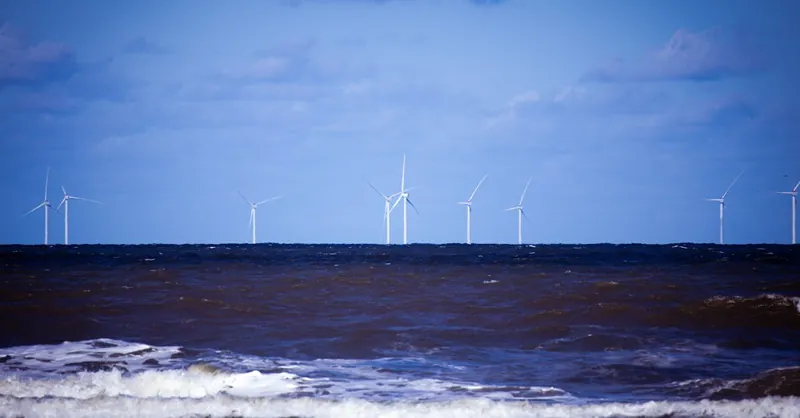
Image courtesy of Patrick
Future Trends and Emerging Technologies: Ultra-Light Materials, Digital Twins, and Hybrid Renewable Integration
Looking ahead, wind turbine blade design continues to evolve through revolutionary future trends and emerging technologies that promise to boost efficiency, reliability, and integration within broader renewable energy systems. Among these advancements, the development of ultra-lightweight materials, use of digital twins for virtual blade modeling and predictive maintenance, and the seamless integration of wind turbines into hybrid renewable energy systems stand out as key drivers shaping the next generation of wind power.
Ultra-Light Materials: Pushing the Limits of Strength and Weight
Building upon carbon fiber composites, researchers are exploring next-generation ultra-light materials such as graphene-enhanced polymers, carbon nanotube composites, and bioinspired nanostructures. These materials offer exceptional strength-to-weight ratios and fatigue resistance, enabling even longer blades with reduced mass. Lighter blades not only mitigate gravitational and centrifugal loads but also allow turbines to spin up more quickly at low wind speeds, increasing overall energy output. Additionally, ultra-light materials can reduce support structure requirements and lower production costs, advancing system scalability and sustainability.
Digital Twins: Virtual Modeling for Performance Optimization and Predictive Maintenance
The advent of digital twin technology introduces a powerful tool for the wind industry by creating exact virtual replicas of turbine blades that mirror real-time operating conditions through sensor inputs and simulation models. Digital twins enable:
- Detailed performance analysis of aerodynamic behavior and load responses across varying environmental conditions.
- Predictive maintenance scheduling by forecasting wear, fatigue, and potential faults before they cause downtime.
- Design optimization through iterative adjustments virtually, accelerating innovation cycles without costly physical prototypes.
By harnessing advanced computational capabilities, digital twins facilitate data-driven decision-making that maximizes energy production while minimizing operational risks and maintenance expenses.
Hybrid Renewable System Integration: Synergizing Wind with Solar and Storage
As the renewable energy landscape diversifies, wind turbine blades and turbines are increasingly designed with hybrid system integration in mind. Combining wind power with solar photovoltaics, battery storage, or other renewable sources requires adaptable turbine controls and dynamic blade technologies that can optimize energy capture in fluctuating conditions and coordinate with energy storage devices. Key benefits include:
- Smoother power output through complementary generation profiles of wind and solar.
- Enhanced grid stability by balancing intermittency with integrated storage.
- Improved resource utilization, maximizing renewable energy penetration on the grid.
Future wind blades will likely incorporate smart control algorithms capable of interfacing with hybrid systems, optimizing operational parameters to align with broader energy management strategies.
Together, these emerging technologies signify an exciting future for wind turbine blade design—where ultra-light materials, digital twin analytics, and hybrid energy integration converge to create more efficient, resilient, and versatile wind energy solutions. This convergence not only enhances individual turbine performance but also accelerates the global transition toward a sustainable, clean energy future.
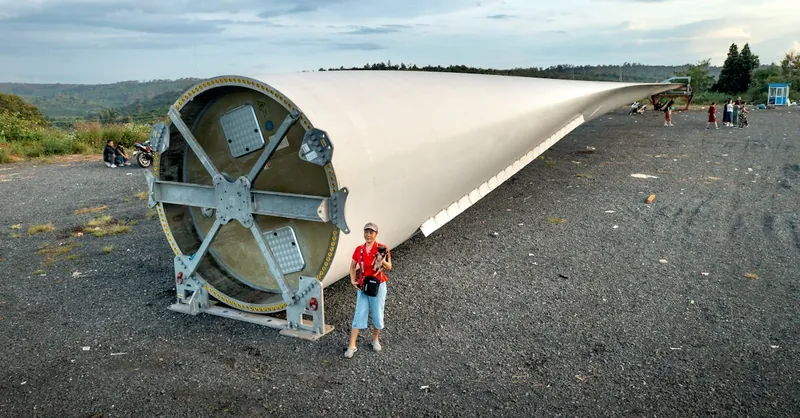
Image courtesy of Quang Nguyen Vinh
